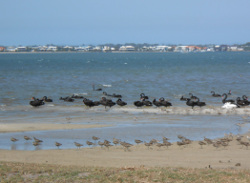|
|
Pressures on shorebirdsMigratory shorebirds in the East Asian—Australasian Flyway depend on breeding habitats in the Arctic and sub-Arctic and non-breeding (over-wintering) habitats in the Southern hemisphere, primarily in Australasia. Shorebirds also require sufficient food at stopover sites along their migration routes and such sites are critically important to the survival of shorebirds. Quick facts
Shorebirds are vulnerable to hunting pressure, habitat changes, disturbance and other threats over their entire geographic range. Cumulative risks to the health and survival of shorebirds occur throughout the Flyway and together determine the conservation status of a species. Poor breeding performance in any one year may be exacerbated by habitat degradation at a stopover site and excessive human disturbance on the wintering grounds. Habitat loss is potentially most serious at stopover sites because the population of an entire species or subspecies can be dependent upon just a few sites. A major stopover site for some species is the Yellow Sea between China and Korea. Assessment of change across >4,000 km of the Yellow Sea coastline discovered vast losses of the region's principal coastal ecosystem, tidal flats, driven primarily by urban, industrial, and agricultural land reclamations[1]. Disturbance of roosting or feeding shorebirds can be a major concern along coastlines. When shorebirds take flight because a person, animal, car or boat disturbs them, they use up vital energy. This means the birds may not gain enough condition for migration and/or breeding. Repeated disturbance can worsen the problem. Migratory shorebirds are most vulnerable to disturbances if they occur in March/April before they depart for the northward migration and in September/October when they have just returned to Australia and are recovering from their travel. Studies on feeding birds show the distance people walking can approach birds before they take flight varies from 125 m for whimbrels to 25 m for red-necked stints. Some shorebirds can adapt to regular disturbances at predictable distances, for instance a walking track, railway line or boat course that limits the movement of people, their pets or vehicles. Sudden, loud, unpredictable disturbances are the most threatening to shorebirds. High impact disturbances include shouting, people running, jet skis, helicopters, kite boards, fast and noisy boats, and dogs. Education and regulation may be used to minimise disturbance. Restrictions may be necessary for certain activities such as bait-digging, flying below a certain height, walking dogs and fast boat travel in areas where shorebirds occur. Avoidance and refuge areas may be designated and, at least for some of the tidal cycle, they may become off limits to humans. Breeding resident shorebirdsBreeding resident shorebirds (e.g. those birds that don’t migrate along the Flyway) such as the pied oystercatcher, sooty oystercatcher, beach stone-curlew, red-capped plover and black-winged stilt breed on the upper beach, foredune, close to the water’s edge in low vegetation or on slightly raised sites in shallow water and are at particular risk. Trampling and other disturbance of nests, eggs or chicks, or continued disturbance of brooding adults may all result in low reproductive rates of a local population. Specific education and management programs may be needed to manage these threats. Additional informationCoastal high-tide shorebird habitat management guidelines Guidelines for restoring and managing wetland habitat for Latham’s Snipe Department of the Environment, Tourism, Science and Innovation—Interacting with shorebirds Firework impacts on shorebirds. References
Last updated: 2 February 2021 This page should be cited as: Department of Environment, Science and Innovation, Queensland (2021) Pressures on shorebirds, WetlandInfo website, accessed 8 May 2025. Available at: https://wetlandinfo.des.qld.gov.au/wetlands/management/bird-management/pressures.html |

 — Department of the Environment, Tourism, Science and Innovation
— Department of the Environment, Tourism, Science and Innovation


